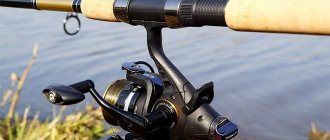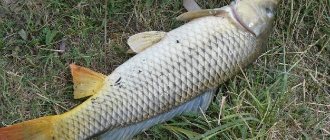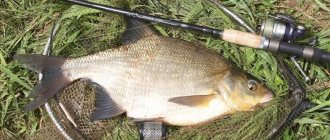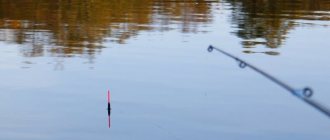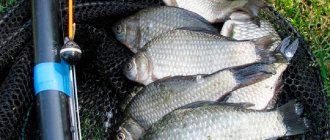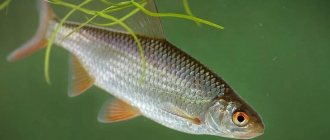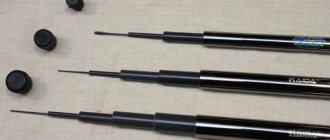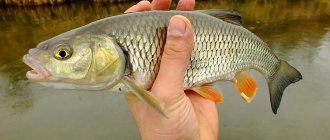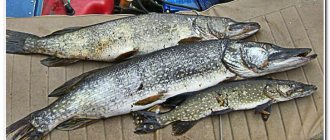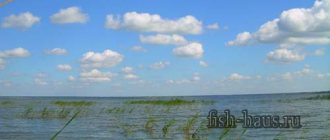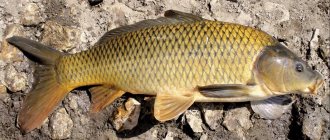Catching a large carp is a reason for pride for the rest of your life. Fishing for carp on the river in summer is very productive. A bite from this powerful fish makes your heart beat faster, and fishing can be compared to a wrestling match. Anyone who experiences this will remember these moments forever.
Sazan is indeed a very strong opponent. To defeat him, you need to have nerves of steel and strong hands. It doesn't just resist, like its cultivated relative the carp. The force with which he pulls the tackle can confuse even experienced fishermen, let alone beginners. Usually, a person who hooks a carp for the first time is seized with real panic.
Content
- Prepare the right bait
- Select a fishing location
- Precisely feed the fishing spot
- Choose a strong fishing rod
- Correct installation of equipment
- Choose the optimal nozzle
- Believe in the chosen fishing spot
- Don't rush into fishing
- Choose the right landing net
Good afternoon, dear readers. This article is devoted to catching the river giant, one of the most beautiful and powerful fish in the world, the river carp. Many fishermen believe that carp and carp are different types of fish, but in fact this is not the case. The Latin name for this fish is Cyprinus carpio, which translates as carp.
It’s just that the lake domesticated form of carp is usually called carp, and the river form, respectively, carp. River carp is a real fighter, it is very difficult to catch it, because this “mustachioed friend” is very smart and capricious, often fishing for carp ends unsuccessfully and fishermen come home with empty cages, to prevent this from happening, I have prepared for you 9 golden rules on how to catch autumn carp on the big river, enjoy reading, friends!
Tackle for carp
The choice of gear for catching such powerful fish as carp must be approached very seriously indeed. It can provide such resistance that you won't even notice your rod cracking. To ensure that you are in control of the situation when fishing for wild carp, it is best to purchase carp rods. Let's take a closer look at each necessary piece of equipment below.
Rod. It is optimal to choose a carp rod with a length of 3.6 meters with a test weight of up to 100 grams when fishing on a lake and with a more powerful test for fishing in the current. Such a rod will be comfortable for fishing and will allow you to send the bait over a fairly long distance. Look at the remaining selection criteria based on your capabilities, mainly focusing on two main factors - price and quality.
reel with a baitrunner and a reliable clutch. Select the capacity of the reel from 4500, and the number of bearings should be at the level of 5 - this is the average value, which usually allows you to fish comfortably. Just take into account the quality of the bearings, because some manufacturers have 12 bearings that will perform worse than 2 from a more reliable brand.
Fishing line . Do not make the equipment too rough by choosing a thick fishing line. If you have a reliable rod and reel that will successfully dampen the powerful jerks of the carp, then a 0.25-0.3 mm fishing line will be sufficient, but it is optimal to use a 0.35 mm fishing line - it is both strong enough and not too rough.
A hook for catching carp and carp usually has a round shape and a short shank. In principle, in fishing stores, carp hooks are sold separately from the rest, so it is difficult to make a mistake when choosing. The hook size can range from No. 2-8. You definitely shouldn’t skimp on the hook and you should choose a product from reliable manufacturers - Owner, Gamakatsu, Cobra, Fox, ESP and others.
a sinker between 40-250 grams. In stagnant reservoirs, a load of up to 100 grams is enough, and in reservoirs, with the flow of water, the weight of the cargo sometimes reaches up to 250 grams, because it is important that the bait is not carried downstream.
These are the tips and recommendations for catching carp that the website ryba4ok.ru gave you. I hope the article was useful to you and deserves a 5-star rating. If you have any questions or have something to add, we are waiting for your comments. We will definitely take everything into account and respond to everyone. No tail, no scales!
Prepare the right bait
The first rule is to prepare the right bait. Carp is often called the “river pig” because it is very voracious, one might say that it eats always and everywhere. This is due to some structural features of its body; carp, like all fish of the carp family, does not have a stomach, which forces it to eat a lot. The bait should be balanced, proteins, fats and carbohydrates should be present in moderation; carp reacts especially well to maggots, worms, tubifex and bloodworms in the autumn, so adding live bait to the bait will increase the effectiveness of your hunt for the “river monster”. It is important that the bait contains a balance of small dusty particles, which will create a trail of bait at the bottom and pull the carp from long distances to the feeding point, and large particles, which will keep it in your baited area for a long time.
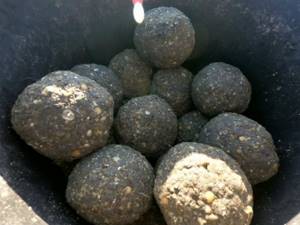
Here is my recipe for bait for carp:
Place 2 cups of peas into boiling water and cook for 25 minutes over high heat. Next, add 2 cups of pearl barley, cook for another 20 minutes, add 2 cups of millet and cook for another 20 minutes over low heat, turn off and add a glass of corn grits + a glass of wheat grits. In cold water, to stimulate appetite, I add 5 tablespoons of salt before cooking. The porridge turns out crumbly, while all the grains are soft. After it cools down, I break this mixture with purchased bait in a 50/50 ratio; the color of the bait should be selected based on the color of the soil at the fishing site, it should approximately match. This complementary food is well molded into lumps and is obtained with moderate viscosity. The main thing is to add clay at great depths and in the current so that it smoothly disintegrates in the water and a trail of bait is formed at the fishing site, the ratio of bait and clay is 50 to 50, the balls need to be sculpted very dense so that they take a long time to disintegrate at the bottom if fishing takes place on a dump , then you need to sculpt the balls in the shape of “pancakes” so that they do not roll down.
This was the recipe for the basic bait with which we feed the fishing point. But there is also a basic mixture that is added to the feeders. This is where it becomes more difficult, the main bait should be of the highest quality, it is better to use purchased bait from proven import brands. I advise you not to look at what is written on the package. Bream, ide, roach, crucian carp - this is increasingly a marketing ploy by manufacturers; for example, I selected for myself the most optimal bait for carp, a series of which is called “bream”. It is important that this bait is fresh, stays well in the feeder, and creates a cloud of turbidity that will attract carp. I mix this bait in a 50/50 ratio with the porridge that I use in the base mixture. In late autumn, I advise you not to go too crazy with flavorings in bait; sometimes it’s better not to add it at all, so as not to scare away wary fish.
Habitats of carp
Carp lives in almost all freshwater bodies of water: rivers, lakes, ponds. It feels especially comfortable in places with a quiet, calm current, and is not attracted to fast-moving rivers. In the wild, the fish is found in the basins of the Black, Azov and Caspian Seas, in the Amur River and in some lakes in central Siberia, where it was artificially introduced. As a rule, carp live in schools, and the larger the fish, the smaller their concentration. Small specimens gather in fairly large flocks.
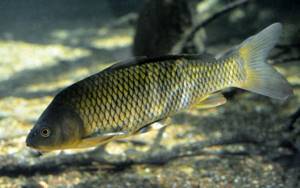
For summer camps, the carp often chooses places with holes and a weak reverse current; it loves muddy soil and a snagy bottom. Places with sharp differences in depth especially attract fish. In lakes it likes to settle among reeds and stops in thickets of water lilies. During hot periods, it becomes active at night, making “travels” along the muddy sections of the river in search of food.
Did you know? The body of the carp has a protective coloring: it is dark on top so that the fish can remain invisible to birds, and on the bottom
—
light, inconspicuous for predatory fish.
Select a fishing location
The second rule is that you need to choose a place where the fish will stay. This is the most difficult point, and at the same time the most important. When choosing a place to catch carp, you need to be sure that it actually lives in this body of water. First, you need to find out from local fishermen and old-timers whether carp are found in the river in which you plan to fish, and it is advisable to collect as much information as possible about promising places where you can catch it. If you have the information, it will be easier for you to navigate and much easier to find these fish. By the way, this year I followed a roughly similar pattern, collected some information on carp, and began searching for it. In autumn, when the water becomes colder than 12 degrees, the carp leaves the channel and rolls into the riverbed to greater depths. It’s worth looking for it in the pits, preferably with a carp nearby. Places where rivers flow into rivers or channels flow out into the riverbed are very promising. This is best done with the help of a motor boat and an echo sounder, which will perfectly show all the changes in depth, snags and even fish at the bottom. By the way, the echo sounder shows carp as a large fish lying on the bottom. As a rule, these are small flocks, from two to six individuals. If you don’t have a boat with an echo sounder, you can use a shore echo sounder, which is cast from a spinning rod and works via Wi-Fi. There is a very large selection of these devices on the modern market; by the way, it helps me out very well in unfamiliar places when fishing from the shore. If you don’t have such things, you will have to navigate the terrain, the depth can be measured using a marker weight and a sliding marker float, bottom unevenness can be felt using a marker weight, but the carapace is perfectly visible visually.
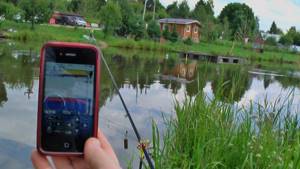
What to catch carp with
When choosing bait, it is very important to take into account the fishing season. The fact is that the diet of carp differs very much depending on the water temperature. So, while the water is still cool - April, May, this fish feeds on animal food, searches for various worms, larvae and mollusks in the silt and thickets of vegetation. During this period, the most effective baits will be:
- crawl out;
- a bunch of dung worms;
- leech;
- pearl barley;
- boilies with the aroma of animal bait.
With the arrival of summer and significant warming of the water, the tastes of carp change and now it is more interested in plant food. He happily eats various aquatic plants, such as water lilies, pondweed, reeds, sedge, etc. And now the most effective way to catch it is:
- boiled potatoes;
- corn;
- peas;
- boilies with sweet flavors;
Carp can maintain a summer diet in the fall, provided that there is no noticeable drop in temperature. As soon as the autumn cooling begins, the fish again begin to respond better to the animal baits that worked in the spring. You can also add crayfish meat to them.
But this does not mean that carp will not be caught in the fall using peas or potatoes. It’s just that in the fall, it’s animal bait that most often brings success. It’s the same in the summer - you can also fish with a crawler, but usually more successful fishing comes out when using plant baits.
Among the most catchy and accessible are peas, corn and potatoes, crawling and a bunch of dung worms. Boilies are also very good, although they are expensive. These are baits that allow you to maximally cut off the bites of small fish and concentrate more on catching carp. Easy to catch and prepare, they can provide effective fishing at any time of the year.
Precisely feed the fishing spot
The third rule is that you need to target the fishing spot, the starting bait should be very voluminous, I usually feed one feeder with 12-15 large balls of basic bait. In my opinion, the most effective way to catch carp is from a boat, and that’s exactly what I did this year. You need to feed a little higher upstream, roughly calculating where the balls will fall, this greatly depends on the depth and strength of the current, usually the balls are carried away 5-10 meters. You need to feed approximately every 2-4 hours to retain as many fish as possible. If you plan to fish from the shore, you can feed the fishing point using a regular rowing boat, having previously marked each feeding spot with a marker (weight with a bottle).
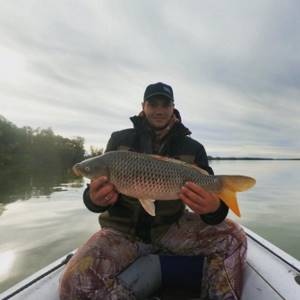
Choose a strong fishing rod
The fourth rule is that it is important to choose the right fishing rod. In fact, you can use a feeder, carp rod, crocodiles, etc., the main thing is that your “stick” is very strong, because carp is a very strong fish that can break a fishing rod not only at the moment of fishing, but also in the process of biting. I like to use feeder rods the most, they perfectly absorb the jerks of the fish, all bites are clearly visible, and they are very durable. I use a feeder with a dough of 150-200g, length 3.3-3.9m with a fast action. By the way, it is very convenient to fish out carp from a boat using a 3.9 m long feeder, my personal observation. I won’t write much about the coil, there is nothing complicated here, the main thing is that it is normal, intact and works well. It is best to fish for carp using a 5000-6000 thousandth reel. In carp fishing, especially when landing trophy fish, it is better to use reels with lower thrust, the optimal gear ratio is 4.9:1 - 5.2:1. Friends, the most important thing is to take your time if even a small carp bites! You need to let it “walk”, don’t be afraid to loosen the clutch, usually after 5-7 minutes the carp gets tired and it’s easier to fish it out, the main thing is to wait out the first powerful jerks of the “river fighter”.
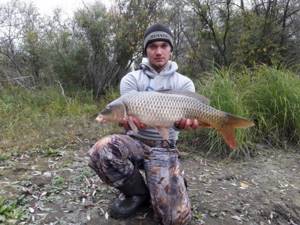
Correct installation of equipment
The fifth rule is that you must make the correct installation of the equipment, so that you do not have breaks, empty bites and offensive trophies. In my opinion, the good old inline is best suited for catching carp on the river.
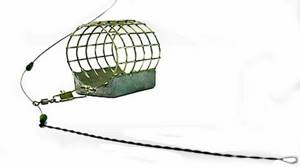
An inline is a feeder that slides along a cord or fishing line, which is locked in any way familiar to you; a leash is already installed below. I use either a bead as a stopper (if the installation is with a swivel) Or I make everything simpler, I stop the feeder with a regular crimping pellet. Lately I have fallen out of love, in my opinion, with unnecessary parts in the equipment, so I don’t use swivels, I just put a pellet in front of the loop. It turns out a sliding feeder that runs along the cord, a stopper, and a loop. Next, we use the loop-to-loop method to fix the twist of the feedergam, with a diameter of 1-1.2 mm. The twist should be twice as long as the feeder, this is necessary so that the leash does not get tangled. Feedergam is an important element of equipment; it provides the necessary shock absorption when fishing for carp; the likelihood of the fish falling off and breaking off, provided that you fished it correctly, will be minimal! Then, we install the leash using the loop-in-loop method. I use leashes 1 - 1.5 meters long, this provides even better shock absorption, the feeder does not interfere with catching the trophy and, in my opinion, the carp is less alarmed by such tackle. Leash thickness 0.22 – 0.28. The main thing is that the fishing line is strong, do not look at what the manufacturer writes on the packaging, check the fishing line with a micrometer for diameter, and with a scale for tensile strength. It is better to use large hooks, number 4-6 according to the international classification.
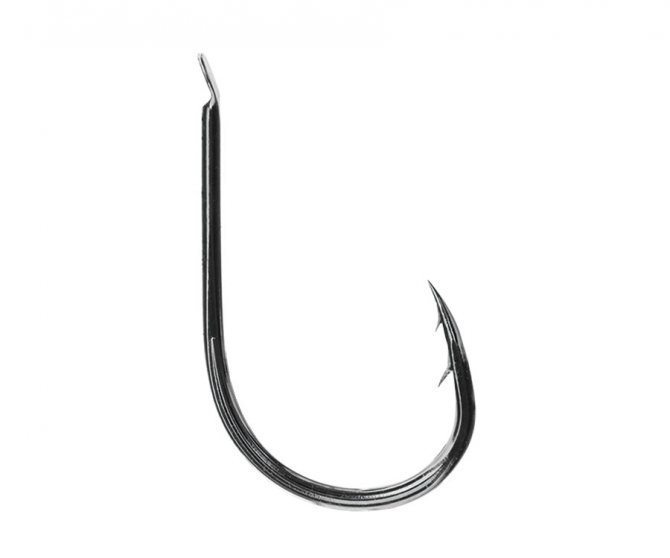
Choose the optimal nozzle
The sixth rule is to choose a nozzle. I advise you to take with you as many different attachments as possible. In autumn, when the water is warmer than 12 degrees, carp eats corn, peas, pearl barley, crust of bread, and boilies very well. In my first autumn forays for carp, at the end of September, the best bait was corn, and the more I put it on the hook, the larger the trophies I came across. As the water cooled, carp were best caught on corn with maggots added, and in mid-October they only pecked on a worm, or a worm-maggot sandwich. A bunch of worms works great in cold water, and I put on a lot of small worms in a bunch. Don’t forget about bloodworms, this is also an excellent bait for this fish in the fall.
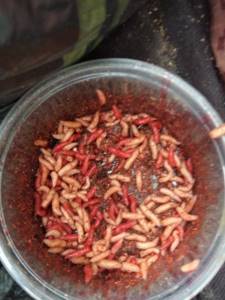
Best fishing time and spawning period
Active fishing for carp begins almost immediately after the ice melts and lasts almost until spawning. At the same time, as the water in the river warms up, the activity of the fish increases. But the real zhor begins immediately after spawning. At this time, the fish greedily pounces on plant and animal food.
Fishing for river carp in most reservoirs lasts until the end of August - beginning of September. The best time of day for fishing is considered to be night, as well as morning and evening dawns.
Spawning of carp occurs when the water temperature reaches 18-20°C, in most reservoirs in Russia - this is the period from mid-May to early June. Spawning occurs in thickets of reeds and other aquatic vegetation in coastal waters; very often the fish enters meadows flooded with water. The usual depth of spawning grounds is no more than 1 meter.
Believe in the chosen fishing spot
The seventh rule is that you must fully believe in the chosen place. Carp fishing is not an active search for fish, you shouldn’t move from place to place every two hours, you need to focus on the selected area, which you have fed abundantly! My first fishing for carp this year turned out to be very nervous. The first day we were unable to get to the fishing point due to bad weather. On the second day, I saw the first bite only 3 hours after feeding, before that, of course, there were a lot of thoughts in my head, but I endured everything, stayed in one place and ended up catching five excellent carp that day. You just need to wait, be patient and most importantly believe in the place, the carp can start pecking immediately after feeding, but sometimes you have to wait for days for its approach, so I advise you to go on such fishing for more than one day. Along with carp, your bycatch will definitely include bream, bream, ide, roach and dace. At this time they live in one place, but when the carp approaches the point, it drives out everyone else, so wait. What to do when there is no bite for a long time? You can read a book, you can leave the spinning rod, you can chat with a friend, just don’t swim to another place!

Choose the right landing net
The ninth rule is that you must have a landing net with you. It should be large in size so that you can easily get trophy fish into it. It is advisable to have a friend with you who will always help. It is very difficult for one person to catch and catch a carp, so I advise you to go on such fishing with a friend who is interested in the hobby, the main thing is that he knows how to work with a landing net.
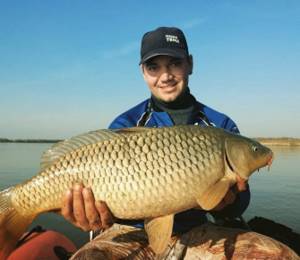
Fishing for carp is a difficult matter that needs to be taken very seriously, because if you want to catch a “river fighter”, then you just need to be able to endure, have physical strength and handle bait, bait and equipment correctly. In my article, I shared with you my experience, which I gained over more than one year. Use my advice, write and ask questions, I’m always happy to help.
Sincerely, Dupin Nikita.
Features of catching carp
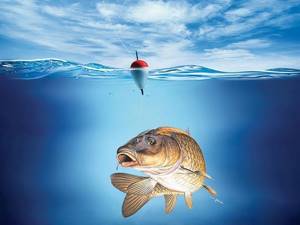
During these “travels” the fish acquires great strength and if the angler is too lazy, it is capable of tearing off the strongest gear with a powerful jerk. Catching carp is the cherished dream of most fishermen, and to achieve this dream they are capable of many sacrifices. Often, a carp session lasts for several days and does not always end in success. The fisherman needs not only to offer the fish his favorite delicacy, but also to attract it to the place where this delicacy is located.
Considering that the area of reservoirs in which carp live and are caught is very large, it is clear how difficult the task of attracting fish is. And there are many questions regarding the equipment used, because bottom carp rigs become useless when the carp is at half-water or loitering just under the surface of the reservoir. Temperature, pressure, and other factors affect the activity of wild carp and influence its choice of stopping place for feeding or resting.
Carp anglers try to catch carp in mid-water or from the surface using a zig-rig, but in reservoirs with a current this method is ineffective, and it is difficult to find an alternative to it, unless, of course, you use the “carp classics”. But thanks to the features of the equipment used, float fishing lovers find, attract and catch carp in any weather, without experiencing any inconvenience.
For many who are not specialists, fishing with a float is associated with sitting on green grass or a wooden bridge and lazily spying on a bright multi-colored float, from time to time signaling that the fish is interested in the bait and is ready to hook. If we talk about catching roach or crucian carp, then this picture has a right to life, but when catching carp, everything is somewhat different and this applies to equipment and installation and other circumstances accompanying fishing.
The float fisherman needs to choose the right place for the session, feed it in such a way as to attract the carp and show all his skill when landing in order not to break the equipment, but to successfully bring the fish into the landing net.
